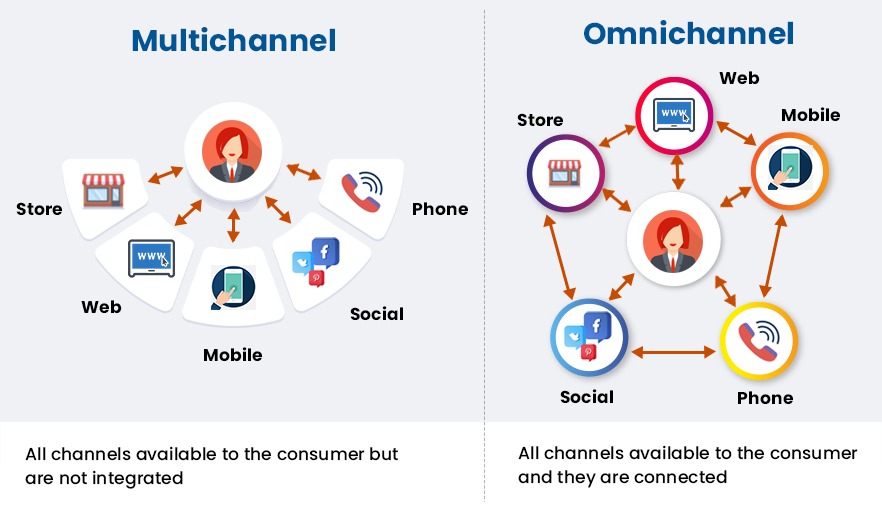
Milli is on her way to a friend’s birthday party, straight from work, and realizes she has left the gift at home. She opens her Dunzo app and gets the gift picked up and dropped at her friend’s place. She uses her QR code scanner to pay for the transaction. It is that simple. The digital world has opened up a whole new realm of possibilities for brands to connect with their customers. The question remains: what is the best approach to using them? In this debate, there are often two terms that are used, often interchangeably. ‘Omnichannel marketing’ and ‘multichannel marketing’ might sound synonymous, but there are subtle differences between the two. How marketers differentiate between these approaches can determine the success of their digital campaigns. So let’s break down the meaning of omnichannel and multichannel.
What is multichannel marketing?
As the name suggests, multichannel marketing simply means the use of multiple channels to reach customers. A typical customer today has a much more complex journey than a customer 20 years ago. They might start their morning by scrolling through Instagram, reading a newspaper during their commute to work, browsing websites through the course of the day, and opening LinkedIn and Facebook to see the latest updates from their friends, family and coworkers.
Multichannel marketing is a strategy that allows brands to advertise on each channel that their customers frequent. For example, while a single-channel marketing strategy might involve advertising only on television, multichannel marketing will include a number of channels in the mix.
In multichannel marketing, while there are a number of channels being used, each of them continues to operate independently of each other. Marketing campaigns on each channel are siloed and customers might be exposed to different messaging by the same brand
Meaning of omnichannel marketing?
Omnichannel might sound the same as multichannel, but there’s one important difference – Each customer touchpoint is not viewed in isolation but as one step in the overall customer journey. For example, a customer might see an advertisement for a product on a social media platform, search for more details and reviews on Google and visit numerous websites over the course of their buying journey before finally committing to purchasing the product.
This marketing strategy is also in line with customer expectations. Customers respond positively to personalized marketing. One study found that 60% of millennials expect a consistent experience across channels.
In omnichannel marketing, each customer touchpoint is not viewed in isolation but as one step in the overall customer journey.

Omnichannel marketing examples
Amazon is the best example of omnichannel marketing. Amazon users have access to their profile on many channels and all provide one consistent experience. These are the
- Amazon website
- Mobile App
- Alexa devices
- Smartwatches
- Physical stores
Target partnered with Pinterest to integrate the Pinterest Lens into the Target app. Now users can take a pic on their smartphones of anything they like and see if Target can give them an option of purchasing a similar item. That is truly what omnichannel marketing is all about – blurring the lines between channels and making it easier for users to get what they want.
It is not only retail stores that do omnichannel marketing, Bank of America uses omnichannel marketing by allowing customers to access free wi-fi to complete bank transactions within a branch or use the ‘robo-branch’ option to address their grievance to a machine and get a resolution instead of waiting for a bank teller.
There are many Indian equivalents. Pepperfry is one of the leading online furniture retailers in India. They also have physical stores that are called ‘experience-zones’ where interior design consultants can provide helpful tips to choosing furniture but the final transaction is done through the online store. 10-15% of sales are currently from these experience zones.
Van Heusen has opened its digitally-immersive flagship store that helps its customers find the best fit, size, and style that uses an infrared ‘fit-scanner’ towards creating a fulfilling experience.
How to get started with an omnichannel strategy
Pivoting from a single-channel or multichannel strategy to an omnichannel outlook can help your brand build stronger recall among customers and create a personalized experience. But how do you get started? Here are three key aspects to keep in mind when framing an omnichannel approach.
1. Shift your focus from channel to customer
A multichannel strategy is simply about casting your brand’s message as far and wide as possible. So you might be using the same promotional ad on Social Media, Search, Display and so on. One of the main differences between omnichannel and multichannel is that the former shifts the focus from the channel to the customer. It isn’t merely about being present on every channel but is about tailoring the messaging for each customer. For example, if a customer has viewed an item on your online retail store but has not purchased it, you can remarket to them through display ads about special offers on that product and send them email reminders about it. This personalizes the customer journey and makes them more likely to convert down the line.
2. Maintain consistency in your messaging
In multichannel marketing, different channels are rarely in sync with each other. You might have five separate campaigns running on each channel. This creates a disjointed experience for the customer as they are exposed to different promotions at various times. It can also be challenging to convert customers using this strategy because promotions are not directed towards a single desired action.
In an omnichannel strategy, the key is to stay consistent with your messaging. Regardless of the channel, the core messaging needs to remain the same. The exact format and tone can change according to the channel, but there needs to be clarity on exactly what you’re promoting and what action you want the customer to take.
3. Use a data-driven messaging strategy
Brands today have a wealth of customer data that can really help fine-tune their messaging strategy. The main advantage that omnichannel marketing offers is that it can help you use data to guide your promotions. For example, you can find out what demographics your audience belongs to, their interests, hobbies and key milestones. You can also find out exactly how they interact with your brand. Did they visit a certain product page, did they watch the entire length of your YouTube ad, have they clicked on a particular search ad? All of this data can help you create personalized lead nurture plans with very specific triggers. It can help you create a holistic marketing strategy that your customers truly resonate with.
Omnichannel marketing has countless benefits, but does that mean you should do away with multichannel marketing entirely? There are certain caveats to the omnichannel vs multichannel debate.
- Firstly, multichannel marketing allows you to test out different messaging options on various channels before finalizing the combination of channel and messaging that performed best. You can then use this winning combo in an omnichannel approach.
- Secondly, you might have very distinct customer groups that prefer certain channels. For example, you might have a more mature audience on Facebook and a younger audience on Instagram. In these cases, you might have to create different messaging approaches for each channel.
At the end of the day, however, personalization remains the most viable way to create winning digital campaigns. An omnichannel strategy can help your brand create highly individual messaging strategies to reach out to your customers consistently over time. The key to effective omnichannel marketing is to implement innovation in a way that works for your brand. Talk to our omnichannel strategists to know more.







